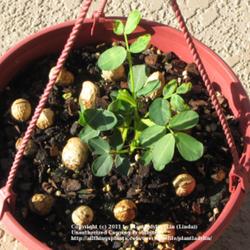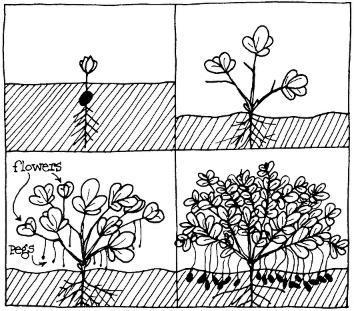
No other vegetable grows like a peanut.
A Peanut's LifeThe peanut seed germinates about two days after planting, when the soil temperature is between 65° and 75° F. A few days later, roots begin to appear and approximately eight days after planting, you'll see shoots poking through the soil's surface.
Within 14 days of planting, small leaves unfold, with each leaf consisting of a slender stem and four leaflets. From these four leaflets new shoots begin to emerge.
The lateral branches that develop are the origin of the flowering branches. Be extremely careful not to injure or bury these branches when cultivating.

Attractive yellow flowers appear approximately six weeks after planting, and the peanut plant starts to resemble a yellow-flowering sweet pea bush. As the small flowers wither, stalklike pegs appear at their bases. Pulled by gravity the pegs curve downward and penetrate the soil to a depth of one to three inches. As the pods begin to form, they shift to a horizontal position. The pods grow and form the tan fruit that we know as unshelled peanuts.
The plants signal that the pods are maturing by starting to turn yellow. This happens when the food supply is consumed by the peanut kernels instead of by the plant. The plants continue to grow and flower for several weeks, however, until they reach one to 1-1/2 feet tall, and each produces at least 40 mature pods. When the plants turn almost completely yellow, it's harvesttime. Don't wait long to harvest because the pods are apt to break off and become lost underground.
Types of PeanutsPeanuts fall into four basic types: Virginia, Runner, Spanish and Valencia.
The low-growing Virginia and Runner plants, which contain two seeds per pod, tend to spread and produce larger nuts than the Spanish type.
Spanish and Valencia, both bunching plants, are small seeded, with the Spanish having two to three seeds per pod and the Valencia having three to six seeds per pod.
Because northern summers are short and peanuts can't tolerate frosty nights, northern gardeners should plant the fastest-growing variety, 'Early Spanish', to make sure that the peanuts can be harvested before there's any sign of frost.
 Victory Seed Company has all the seeds you want for your best garden in 2024.
Victory Seed Company has all the seeds you want for your best garden in 2024.
For 25 years, the family-owned Victory Seed Company has provided the highest quality vegetable, herb and flower seeds to families across the country. We are passionate about providing you the best seeds available that give excellent germination, robust plants, and the harvest you want. With a catalog of over a thousand varieties, we have everything, and our prices are the kinds that we'd want to pay. We have hundreds of yesterday's heirloom vegetables, as well as today's award winning hybrid selections. Get to know us by visiting our website and browsing through our online vegetable seed catalog.
| 1. Preparing to Plant Peas |
| 2. Choosing Pea Varieties |
| 3. Perfecting Your Soil for Peas |
| 4. Growing Peas in Raised Beds |
| 5. About Peanuts |
| 6. How Peanuts Grow ← you're on this article right now |
| 7. Planting Preparation for Peanuts |
| 8. Pea Essentials |
| 1. Preparing to Plant Peas |
| 2. Choosing Pea Varieties |
| 3. Perfecting Your Soil for Peas |
| 4. Growing Peas in Raised Beds |
| 5. About Peanuts |
| 6. How Peanuts Grow ← you're on this article right now |
| 7. Planting Preparation for Peanuts |
| 8. Pea Essentials |